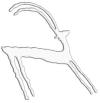Ērān ud Anērān
Webfestschrift Marshak 2003
[index]

Ērān ud Anērān |
Transoxiana
|
This offering to Boris Marshak acknowledges his profound contributions to Iranian studies, particularly in the fields of metalwork and Sogdian art and archaeology, and expresses this author?s deep appreciation for his long friendship. His gift for illuminating the past has earned the gratitude of the scholarly community, but has also touched this author personally, leaving the indelible and treasured memory of an early evening walk through Leningrad during which he vividly recreated for an awed graduate student the city and culture of Sankt Petersburg.
The so-called Bactrian documents, which have been known since the 1990s, have expanded knowledge of the Bactrian language and as well as that of the history and culture of northern Afghanistan from the first half of the 4th century to the later part of the 8th century CE. Now numbering more than 150, the documents have been acquired by several dealers and collectors. Those belonging to the Dr. D.N. Khalili represent the largest collection; it is an overview of the clay sealings that had secured the documents -many with the sealings still attached- that is the subject of this paper.
The documents comprise two distinct types, legal or economic texts and private letters, and basically two types of sealing methods. While the letters are secured by a single sealing, the legal documents typically are secured by multiple sealings (the principal contractor or contractors and seals of witnesses to the transaction). The letters are written once and then sealed, but the legal documents are written in duplicate on a single sheet; a lower or open copy of the document and an upper or closed copy, rolled and tied with strings and thongs inserted through hole pierced in the space between the two copies, that can be opened and consulted in case the lower copy is damaged or changed. Each seal is applied to the side of a string- hole and attached by a thong or string. The name of the seal-owner or ?user is sometimes written on the back of the open copy so as to correspond to the order of the sealings on the closed copy.
Some of the seals used may be considerably older than the date of the document, perhaps even heirlooms, or may be borrowed as the name inscribed on the seal corresponds neither to that of the seal-user nor to any ancestor named in the document. Another feature of the documents is the use of seals that are blank on the impressed surface but are in the shape of a fingernail.
The images on the sealings represent a wide range of motifs and styles, which is not surprising given the more than four-century span of the documents. However, it is remarkable that a single document typically bears several impressions that represent seals of very different styles and presumably of very different origins. This further suggests the use of heirloom or antique seals, although it cannot account for the diversity of the images and styles. Study of the sealings -their actual usage, their iconography and their style- helps to shed light on the social interactions, religious beliefs, and artistic influences that were at play during this period in this heretofore little known region.
* Independent Art Historian, New York (USA)
Actualizado el 24/07/2004